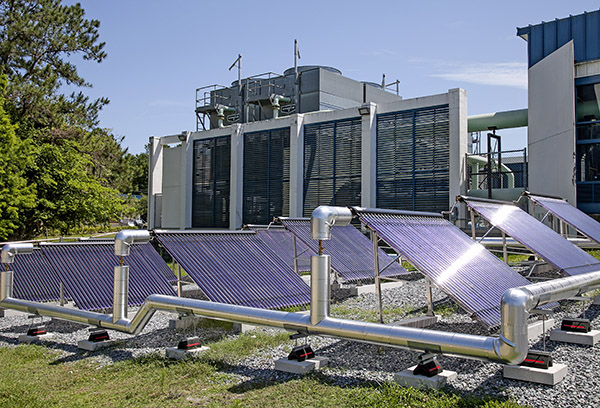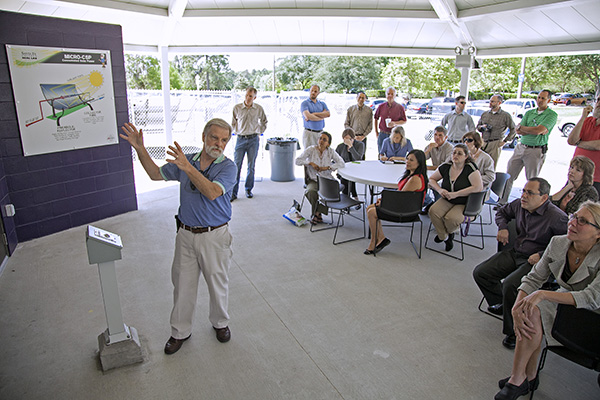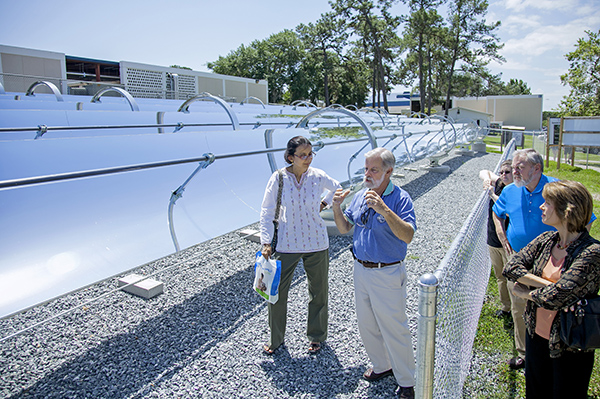The Renewable Energy Accessible (REAL) Lab at Santa Fe College’s Northwest Campus offers students a unique opportunity to learn about the solar energy technologies that are replacing the use of dwindling supplies of coal, gas and oil. The timing couldn’t be better, because innovative California companies such as Apple and Google are leading the shift away from fossil fuels toward renewable energy sources at the same time that Tesla Energy—also in California—is breaking new ground with its Powerwall home battery that stores solar energy.
Inside a chain-link fence across the street from the gymnasium, the REAL Lab’s reflective silver arrays glint and shine in the sunlight. An accessible teaching/learning Solar Pavilion lets instructors, students and visitors page through an interactive show that explains how these new technologies work.
In the presentation, a gray-haired cartoon figure in sunglasses introduces visitors to “The Carbonator,” a dirty villain who gets power from pollution when energy is produced from burning fossil fuels. The heroes who must conquer The Carbonator are the cleaner solar energy technologies in the REAL Lab’s array—the photovoltaic panels that convert sunlight into electricity at the atomic level and the evacuated tube array and silver parabolic trough collectors that convert sunbeams into heat or thermal energy. But this equipment is not just for show; it provides energy that helps to run the boiler plant that heats hot water for the Northwest Campus.
The REAL Lab is the brainchild of Associate Vice President of Facilities Services Bill Reese, the real-life double of—and inspiration for—the silver-haired cartoon guide in the pavilion’s slide show. When Reese retires this year after spending over 15 years at SF College, the lab will become part of his legacy.
“I knew that the college wanted to engage students in sustainability, but the question for me was, ‘How?’” Reese explained as he described his vision for the lab. “There isn’t another facility like this one anywhere, so we had to create it from scratch.”
Sustainability is defined as the idea of not harming the environment or depleting natural resources coupled with the goal of maintaining long-term ecological balance. The REAL lab is a direct result of SF College President Jackson Sasser’s 2007 initiative to infuse discussions about sustainability into courses in different academic disciplines. Assistant Vice President for Academic Affairs Vilma Fuentes is currently leading that effort.
“With the Teaching Zoo, the North Woods, the Rock Cycle Garden and now the REAL Lab, we have what I call a ‘sustainability crescent’ that encircles the north end of campus,” Fuentes explained. “Each of these facilities enables our students to gain personal or even hands-on experience with the things they learn about in class.”
“‘Sustainability’ is a new term, but ‘energy conservation’ is not, and we were already saving megawatts here on campus,” Reese explained. “We had two solar photovoltaic (PV) systems that have helped us reduce our energy from 84 to 54 kBtu (1000 British thermal units) per square foot in 10 years, even though we added nearly 100,000 square feet of building space in that same time. When we installed those PV systems, we calculated that with state rebates and the solar feed-in tariff from Gainesville Regional Utilities, the systems would pay for themselves in about 11 years.” Using those systems to educate students was not an option, however, because both systems are on building roofs—one on the Lawrence W. Tyree Library and the other on the Charles R. Perry Construction Institute.
As he considered installing new solar energy systems that could help to power the boiler plant, Reese’s “Aha!” moment came when he started to think not only about financial payback but also about educational payback. “I decided I would try to bring in more than one technology that would be accessible to students, so they could learn about the different types of solar collectors,” he said.
His research revealed that the kind of renewable energy educational lab Reese envisioned did not exist, so he decided to create it. He chose the types of systems he wanted to include and weighed the financial payback of those systems with the educational payback. He approached Sasser, who supported the idea and took it to the college’s Board of Trustees. With board support and funds from state and local energy rebates, Reese developed a site plan and began to look for vendors who could supply the needed equipment.
“The trough collectors came from Canada and the solar film came from Europe,” Reese said. “We contracted with a local company, Solar Impact, to install the equipment, and we’re working on a communications link with Rackam, a company in Quebec, so they can calibrate the troughs to track the sun throughout the day. We incorporated the pavilion into the design so that students and other people can learn about the solar technologies whether they visit the lab with a faculty member or not.”
“Instead of just talking about sustainability, the REAL Lab is a way to get sustainability into classes in multiple disciplines and make it a focus for students,” Reese continued.
Fuentes echoes that view. “The lab highlights the practical application of math and science in real life and in technical career fields such as building construction,” she said. “Students can see the different solar technologies, have conversations about how they work, page through the program in the pavilion, and use what they learn in class assignments. We have one instructor who is going to use the lab to teach students how to calculate the energy footprints of buildings. Those kinds of assignments are impossible at places where people don’t want to share information about the technologies they’re using or the square footage of their buildings, but here at Santa Fe, all that information is available to our students.”
The STEM (science/technology/engineering/mathematics) fields are not the only ones that will use the REAL Lab. “We expect professors in other disciplines to step forward as the equipment begins to be used,” Fuentes added. “For example, professors in English could have their students write about how using energy from sunbeams can reduce pollution.”
The lab also offers a way to introduce younger students to solar technologies and the opportunities that are open to them in scientific and technical careers. “The REAL Lab is an amazing outreach opportunity for children and young people in the K-12 school system because it highlights how math and science affect our daily lives in practical ways,” Fuentes pointed out. “The lab makes those lessons fun and interactive for young people who visit the college on school field trips or with their families.”
“This is the only time in my experience in higher education where a transformative instructional tool has been envisioned, planned and executed by a lead facilities manager,” Sasser said. “The REAL Lab will serve as a demonstration for hundreds of students to learn about one of our highly valued aspirations at Santa Fe College and that is sustainability.”
According to the Obama administration’s Youth Sustainability Challenge, “America’s youth and young adults have unlimited potential to generate innovative solutions to environment and energy challenges, and make an impact in their homes, schools, communities and beyond…We need your energy, innovation, and expertise to create and advance the sustainability solutions of the 21st century.”
Creation of the REAL lab at Santa Fe College in Florida supports the government’s challenge and demonstrates that innovation is not limited to high-tech companies in California.
“We need to develop new technologies that are more efficient 24 hours a day,” Reese concluded, “and if the REAL Lab can inspire students and infuse enough of them with a passion for careers in technology and renewable energy, they will graduate, go out and get jobs and create even more innovations.”



